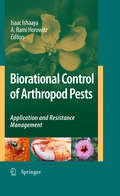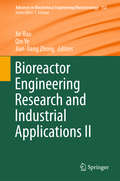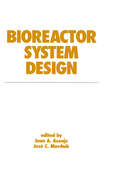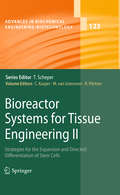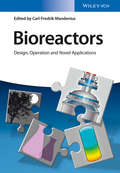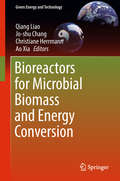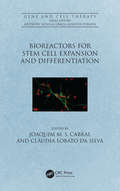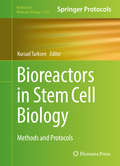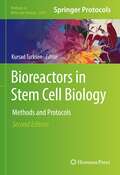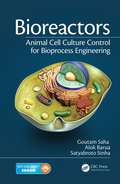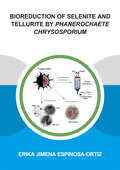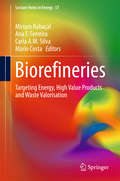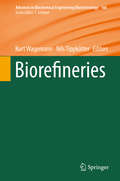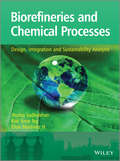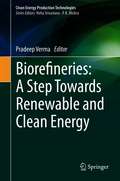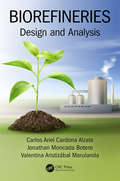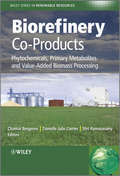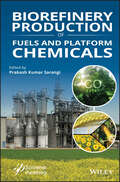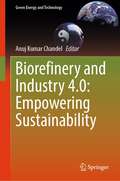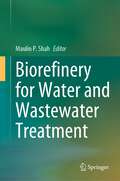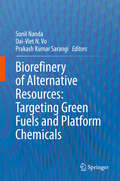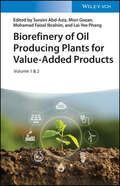- Table View
- List View
Biorational Control of Arthropod Pests: Application and Resistance Management
by Isaac Ishaaya A. Rami HorowitzThis book deals with various approaches for arthropod pest control. One approach is based on disrupting the activity of specific biochemical sites such as neuropeptides, ecdysone and juvenile hormones or tyramine, octopamine and GABA receptors. Another approach is the use of natural products obtained from tropical plants and other biological systems for pest control. Finally, the exploiting of genetically modified insects, plants and symbionts along with male/female call disturbance are important novel tools in crop protection. Countermeasures for resistance to biorational control agents using advanced biological and biochemical approaches are discussed.
Bioreaction Engineering Principles: Second Edition
by Gunnar Lidén Jens Nielsen John VilladsenThe present text is a complete revision of the 2nd edition from 2003 of the book with the same title. In recognition of the fast pace at which biotechnology is moving we have rewritten several chapters to include new scientific progress in the field from 2000 to 2010. More important we have changed the focus of the book to support its use, not only in universities, but also as a guide to design new processes and equipment in the bio-industry. A new chapter has been included on the prospects of the bio-refinery to replace many of the oil- and gas based processes for production of especially bulk chemicals. This chapter also serves to make students in Chemical Engineering and in the Bio-Sciences enthusiastic about the whole research field. As in previous editions we hope that the book can be used as textbook for classes, even at the undergraduate level, where chemical engineering students come to work side by side with students from biochemistry and microbiology. To help the chemical engineering students Chapter 1 includes a brief review of the most important parts of microbial metabolism. In our opinion this review is sufficient to understand microbial physiology at a sufficiently high level to profit from the rest of the book. Likewise the bio-students will not be overwhelmed by mathematics, but since the objective of the book is to teach quantitative process analysis and process design at a hands-on level some mathematics and model analysis is needed. We hope that the about 100 detailed examples and text notes, together with many instructive problems will be sufficient to illustrate how model analysis is used, also in Bio-reaction Engineering.
Bioreactor Engineering Research and Industrial Applications I (Advances in Biochemical Engineering/Biotechnology #152)
by Jian-Jiang Zhong Qin Ye Jie BaoThis book review series presents current trends in modern biotechnology. The aim is to cover all aspects of this interdisciplinary technology where knowledge, methods and expertise are required from chemistry, biochemistry, microbiology, genetics, chemical engineering and computer science. Volumes are organized topically and provide a comprehensive discussion of developments in the respective field over the past 3-5 years. The series also discusses new discoveries and applications. Special volumes are dedicated to selected topics which focus on new biotechnological products and new processes for their synthesis and purification. In general, special volumes are edited by well-known guest editors. The series editor and publisher will however always be pleased to receive suggestions and supplementary information. Manuscripts are accepted in English.
Bioreactor Implementation in the Agro-Food Industries: Technology, Kinetics and Modelization (ISTE Consignment)
by Mohamed GhoulThe use of bioreactors in food ingredient production has expanded rapidly in recent years. These processes create a controlled environment that is tailored to the specific needs of each microorganism, while also minimizing their environmental impact. However, to optimize the implementation of these processes, it is necessary to master a number of scientific concepts relating to material and heat balances, thermodynamics, microbial kinetics, extrapolation and agitation techniques, as well as the techno-economic analysis of processes. This book aims to provide an exhaustive and precise presentation of all of these concepts, making them accessible to students, researchers and professionals alike. Bioreactor Implementation in the Agro-Food Industries is structured in two complementary parts. The first part outlines the essential principles of bioreactor engineering. This knowledge is essential if we are to master the biological and physico-chemical processes that take place in bioreactors. The second part presents practical examples of the use of bioreactors for the production of several ingredients and metabolites of interest.
Bioreactor System Design (Biotechnology and Bioprocessing)
by Juan A. AsenjoDescribes the state-of-the-art techniques and methods involved in the design, operation, preparation and containment of bioreactor systems, taking into account the interrelated effects of variables associated with both upstream and downstream stages of the design process. The importance of the initial steps in the development of a bioprocess, such
Bioreactor Systems for Tissue Engineering II: Strategies for the Expansion and Directed Differentiation of Stem Cells (Advances in Biochemical Engineering/Biotechnology #123)
by Ralf Pörtner Cornelia Kasper Martijn Van GriensvenAlternative Sources of Adult Stem Cells: Human Amniotic Membrane, by S. Wolbank, M. van Griensven, R. Grillari-Voglauer, and A. Peterbauer-Scherb; * Mesenchymal Stromal Cells Derived from Human Umbilical Cord Tissues: Primitive Cells with Potential for Clinical and Tissue Engineering Applications, by P. Moretti, T. Hatlapatka, D. Marten, A. Lavrentieva, I. Majore, R. Hass and C. Kasper; * Isolation, Characterization, Differentiation, and Application of Adipose-Derived Stem Cells, by J. W. Kuhbier, B. Weyand, C. Radtke, P. M. Vogt, C. Kasper and K. Reimers; * Induced Pluripotent Stem Cells: Characteristics and Perspectives, by T. Cantz and U. Martin; * Induced Pluripotent Stem Cell Technology in Regenerative Medicine and Biology, by D. Pei, J. Xu, Q. Zhuang, H.-F. Tse and M. A. Esteban; * Production Process for Stem Cell Based Therapeutic Implants: Expansion of the Production Cell Line and Cultivation of Encapsulated Cells, by C. Weber, S. Pohl, R. Poertner, P. Pino-Grace, D. Freimark, C. Wallrapp, P. Geigle and P. Czermak; * Cartilage Engineering from Mesenchymal Stem Cells, by C. Goepfert, A. Slobodianski, A.F. Schilling, P. Adamietz and R. Poertner; * Outgrowth Endothelial Cells: Sources, Characteristics and Potential Applications in Tissue Engineering and Regenerative Medicine, by S. Fuchs, E. Dohle, M. Kolbe, C. J. Kirkpatrick; * Basic Science and Clinical Application of Stem Cells in Veterinary Medicine, by I. Ribitsch, J. Burk, U. Delling, C. Geißler, C. Gittel, H. Jülke, W. Brehm; * Bone Marrow Stem Cells in Clinical Application: Harnessing Paracrine Roles and Niche Mechanisms, by R. M. El Backly, R. Cancedda; * Clinical Application of Stem Cells in the Cardiovascular System, C. Stamm, K. Klose, Y.-H. Choi
Bioreactors
by Carl-Fredrik MandeniusIn this expert handbook both the topics and contributors are selected so as to provide an authoritative view of possible applications for this new technology. The result is an up-to-date survey of current challenges and opportunities in the design and operation of bioreactors for high-value products in the biomedical and chemical industries. Combining theory and practice, the authors explain such leading-edge technologies as single-use bioreactors, bioreactor simulators, and soft sensor monitoring, and discuss novel applications, such as stem cell production, process development, and multi-product reactors, using case studies from academia as well as from industry. A final section addresses the latest trends, including culture media design and systems biotechnology, which are expected to have an increasing impact on bioreactor design. With its focus on cutting-edge technologies and discussions of future developments, this handbook will remain an invaluable reference for many years to come.
Bioreactors for Microbial Biomass and Energy Conversion (Green Energy And Technology)
by Qiang Liao Jo-Shu Chang Christiane Herrmann Ao XiaThis book discusses recent trends and developments in the microbial conversion process, which serves as an important route for biofuel production, with particular attention to bioreactors. It combines microbial conversion with multiphase flow and mass transfer, providing an alternative perspective for the understanding of microbial biomass and energy production process as well as enhancement strategy. This book is relevant to students and researchers who work in the fields of renewable energy, engineering and biotechnology. Policymakers, economists and industry engineers also benefit from this book, as it can be used as a resource for the implementation of renewable energy technologies.
Bioreactors for Stem Cell Expansion and Differentiation (Gene and Cell Therapy)
by Joaquim M.S. Cabral Claudia Lobato da SilvaAn international team of investigators presents thought-provoking reviews of bioreactors for stem cell expansion and differentiation and provides cutting-edge information on different bioreactor systems. The authors offer novel insights into bioreactor-based culture systems specific for tissue engineering, including sophisticated and cost-effective manufacturing strategies geared to overcome technological shortcomings that currently preclude advances towards product commercialization. This book in the fields of stem cell expansion, bioreactors, bioprocessing, and bio and tissue engineering, gives the reader a full understanding of the state-of-art and the future of these fields. Key selling features: Describes various bioreactors or stem cell culturing systems Reviews methods for stem cell expansion and differentiation for neural, cardiac, hemopoietic, mesenchymal, hepatic and other tissues cell types Distinguishes different types of bioreactors intended for different operational scales of tissue engineering and cellular therapies Includes contributions from an international team of leaders in stem cell research
Bioreactors in Stem Cell Biology: Methods and Protocols (Methods in Molecular Biology #1502)
by Kursad TurksenThis meticulous volume recognizes the need to translate what has been learned primarily in tissue culture dishes to approaches supporting scale-up studies, not only to large quantities of cells but also to heterogeneous cell constructs. Notable advances are being made in these latter approaches, prompting this collection of a variety of representative protocols that facilitate important modifications and novel approaches to bioreactors in stem cell research, contributed by both established and new investigators in this area. Written for the highly successful Methods in Molecular Biology series, chapters include introductions to their respective topics, lists of the necessary materials and reagents, step-by-step, readily reproducible laboratory protocols, and tips on troubleshooting and avoiding known pitfalls. Practical and authoritative, Bioreactors in Stem Cell Biology: Methods and Protocols will serve as an ideal guide for scientists seeking to increase our understanding of stem cells and their potential to repair and regenerate tissues and organs.
Bioreactors in Stem Cell Biology: Methods and Protocols (Methods in Molecular Biology #2436)
by Kursad TurksenThis new edition brings together some of the latest developments and protocols reflecting the rapidity with which bioreactor technologies are advancing and being applied. Given that the use of bioreactors in cell biology is becoming more commonplace as attempts are made to scale-up production of various types of cells for regenerative medicine and pharmaceutical purposes, this volume provides practical guidance for navigating research projects. Written for the highly successful Methods in Molecular Biology series, chapters include introductions to their respective topics, lists of the necessary materials and reagents, step-by-step, readily reproducible laboratory protocols, and tips on troubleshooting and avoiding known pitfalls. Authoritative and cutting-edge, Bioreactors in Stem Cell Biology: Methods and Protocols, Second Edition will benefit both established investigators and newcomers to this dynamic area of study.
Bioreactors: Animal Cell Culture Control for Bioprocess Engineering
by Goutam Saha Alok Barua Satyabroto SinhaBioreactors: Animal Cell Culture Control for Bioprocess Engineering presents the design, fabrication, and control of a new type of bioreactor meant especially for animal cell line culture. The new bioreactor, called the "see-saw bioreactor," is ideal for the growth of cells with a sensitive membrane. The see-saw bioreactor derives its name from its principle of operation in which liquid columns in either limb of the reactor alternately go up and down. The working volume of the reactor is small, to within 15 L. However, it can easily be scaled up for large production in volume of cell mass in the drug and pharmaceutical industries.The authors describe the principle of operation of the see-saw bioreactor and how to automatically control the bioprocess. They discuss different control strategies as well as the thorough experimental research they conducted on this prototype bioreactor in which they applied a time delay control for yield maximization.To give you a complete understanding of the design and development of the see-saw bioreactor, the authors cover the mathematical model they use to describe the kinetics of fermentation, the genetic algorithms used for deriving the optimal time trajectories of the bioprocess variables, and the corresponding control inputs for maximizing the product yield. One chapter is devoted to the application of time delay control. Following a description of the bioreactor’s working setup in the laboratory, the authors sum up their investigation and define the future scope of work in terms of design, control, and software sensors.
Bioreduction of Selenite and Tellurite by Phanerochaete Chrysosporium (IHE Delft PhD Thesis Series)
by Erika Jimena Espinosa-OrtizSelenium (Se) and tellurium (Te) are metalloids of commercial interest due to their physicochemical properties. The water soluble oxyanions of these elements (selenite, selenate, tellurite and tellurate) exhibit high toxicities; hence, their release in the environment is of great concern. This study demonstrates the potential use of fungi as Se- and Te-reducing organisms. The response of Phanerochaete chrysosporium to the presence of selenite and tellurite was evaluated, as well as its potential application in wastewater treatment and production of nanoparticles. Growth stress and morphological changes were induced in P. chrysosoporium when exposed to selenite and tellurite. Synthesis of Se0 and Te0 nanoparticles entrapped in the fungal biomass was observed, as well as the formation of unique Se0-Te0 nanocomposites when the fungus was cultivated concurrently with Se and Te. The response of P. chrysosporium to selenite exposure was investigated in different modes of fungal growth (pellets and biofilm). A bioprocess for selenite removal and Se0 nanoparticles recovery using an up-flow fungal pelleted reactor was developed. 70% selenite removal (10 mg Se L-1 d-1) was achieved under continuous mode. The use of Se0 nanoparticles immobilized in P. chrysosporium pellets as a new sorbent material for the removal of heavy metals from wastewater was demonstrated.
Biorefineries
by Miriam Rabaçal Ana F. Ferreira Mário Costa Carla A. SilvaThis book addresses the potential of the transformation of biomass into a wide range of marketable products, and examines the biological, biochemical, physical and thermal processing of biomass into products such as fuels, power, heat, feeds, chemicals and materials. Respective chapters explore various topics including biomass characterization, biomass pre-conditioning and sustainability analysis, aspects that are supplemented by a global overview of their implementation in current pilot bio-refineries. Providing a valuable resource to energy engineers, chemical engineers, biotechnologists and economists, this book will also be of great interest to students and policymakers.
Biorefineries (Advances in Biochemical Engineering/Biotechnology #166)
by Kurt Wagemann Nils TippkötterThis book offers a comprehensive review on biomass resources, examples of biorefineries and corresponding products. The first part of this book covers topics such as different biorefinery resources from agriculture, wood processing residues and transport logistics of plant biomass. In the second part, expert contributors present biorefinery concepts of different biomass feedstocks, including vegetable-oils, sugarcane, starch, lignocellulose and microalgae. Readers will find here a summary of the syngas utilization and the bio-oil characterization and potential use as an alternative renewable fuel and source for chemical feedstocks. Particular attention is also given to the anaerobic digestion-based and Organosolv biorefineries. The last part of the book examines relevant products and components such as alcohols, hydrocarbons, bioplastics and lignin, and offers a sustainability evaluation of biorefineries.
Biorefineries and Chemical Processes
by Elias Martinez Hernandez Jhuma Sadhukhan Kok Siew NgAs the range of feedstocks, process technologies and products expand, biorefineries will become increasingly complex manufacturing systems. Biorefineries and Chemical Processes: Design, Integration and Sustainability Analysis presents process modelling and integration, and whole system life cycle analysis tools for the synthesis, design, operation and sustainable development of biorefinery and chemical processes.Topics covered include:Introduction: An introduction to the concept and development of biorefineries.Tools: Included here are the methods for detailed economic and environmental impact analyses; combined economic value and environmental impact analysis; life cycle assessment (LCA); multi-criteria analysis; heat integration and utility system design; mathematical programming based optimization and genetic algorithms.Process synthesis and design: Focuses on modern unit operations and innovative process flowsheets. Discusses thermochemical and biochemical processing of biomass, production of chemicals and polymers from biomass, and processes for carbon dioxide capture.Biorefinery systems: Presents biorefinery process synthesis using whole system analysis. Discusses bio-oil and algae biorefineries, integrated fuel cells and renewables, and heterogeneous catalytic reactors.Companion website: Four case studies, additional exercises and examples are available online, together with three supplementary chapters which address waste and emission minimization, energy storage and control systems, and the optimization and reuse of water.This textbook is designed to bridge a gap between engineering design and sustainability assessment, for advanced students and practicing process designers and engineers.
Biorefineries: A Step Towards Renewable and Clean Energy (Clean Energy Production Technologies)
by Pradeep VermaThis book provides a comprehensive account of past, present and future of the biomass based biorefineries. It is an all-inclusive and insightful compilation of recent advancements in the technology and methods used for conversion of biomass to bioenergy and other useful biochemicals. The book also focuses on the limitations of existing technologies and provides the future prospects, as well as discusses socio-economic impact of biomass based biorefineries. This book assists researchers in the area of lignocellulosic biorefineries and can be used by the students, scientist and academician as an advanced reference textbook.
Biorefineries: Design and Analysis
by Carlos Ariel Alzate Jonathan Moncada Botero Valentina Aristizábal MarulandaAimed at presenting a systematic design of biorefineries, the book initiates with an overview about relevance and applications explained through origin of raw materials, transformation routes and products. Then, concepts as hierarchy, sequencing and integration are considered which helps in generating a sustainable and strategic design of biorefineries. Further, framework for biorefineries based on techno-economic, environmental and social aspects is analyzed with examples to show the applications. Finally, some mass, energy and economic indices are considered to assess the biorefinery sustainability and key challenges for future development of biorefineries. Key Features Presents current state-of the-art of the biorefineries design and analyses for in depth understanding of biofuels and biomaterials Explores conceptual design of processes Concepts discussed with strong engineering approach, including design strategies and techno-economic analyses Includes bio-based materials, natural products and food products in the biorefinery concept Presentation of structured method to calculate indices of performance of biorefineries
Biorefinery 2030: Future Prospects for the Bioeconomy
by Pierre-Alain Schieb Honorine Lescieux-Katir Maryline Thénot Barbara Clément-LarosièreThis book investigates the functioning and ecosystems of biorefineries and assesses the potential of the industrial bioeconomy. The authors present a case study of the biorefinery at Bazancourt Pomacle, near Reims, France, as an outstanding illustration of the creation, work processes, financing, provision of environmental services, competitive benefits and future prospects of a bioeconomy. Analysing the case of Bazancourt Pomacle, the authors show the wide range of products produced by integrated biorefineries such as food, bioenergy, molecules for cosmetics and nutrients for agricultural use. They also analyse Bazancourt Pomacle as an open innovation platform, which encompasses several layers of R&D, including three department chairs from leading engineering and business schools in France. Illustrating a number of global success stories that started in Bazancourt Pomacle, the authors also investigate the provision of pilot- and demonstration plants as inescapable steps in the scaling-up process from the lab to industrial scale. The book provides a systematic overview of the lessons learned, as well as data on an industrial bioeconomy. Investors, decision- makers, public-policy shapers, analysts and scholars will learn about the history, actors, economics, industrial symbiosis, role of cooperatives, R&D and future prospects of a world-class biorefinery and bio-based cluster in Europe.
Biorefinery Co-Products
by Shri Ramaswamy Chantal Bergeron Danielle Julie CarrierIn order to successfully compete as a sustainable energy source, the value of biomass must be maximized through the production of valuable co-products in the biorefinery. Specialty chemicals and other biobased products can be extracted from biomass prior to or after the conversion process, thus increasing the overall profitability and sustainability of the biorefinery.Biorefinery Co-Products highlights various co-products that are present in biomass prior to and after processing, describes strategies for their extraction , and presents examples of bioenergy feedstocks that contain high value products.Topics covered include:Bioactive compounds from woody biomassPhytochemicals from sugar cane, citrus waste and algaeValuable products from corn and other oil seed cropsProteins from foragesEnhancing the value of existing biomass processing streamsAimed at academic researchers, professionals and specialists in the bioenergy industry, Biorefinery Co-Products is an essential text for all scientists and engineers working on the efficient separation, purification and manufacture of value-added biorefinery co-products.For more information on the Wiley Series in Renewable resources, visit www.wiley.com/go/rrs
Biorefinery Production of Fuels and Platform Chemicals: Production Of Fuels And Platform Chemicals
by Prakash Kumar SarangiBIOREFINERY PRODUCTION OF FUELS AND PLATFORM CHEMICALS From the selection and pretreatment of raw materials to design of reactors, methods of conversion, selection of process parameters, optimization, and production of various types of biofuels to the industrial applications for the technology, this is the most up-to-date and comprehensive coverage of liquid biofuels for engineers and students. Massive use of fossil-based fuels not only create environmental pollution, but these sources are already diminishing. Waste biomass can aid in the production of biobased energy and chemicals. This book is a complete collection of chapters on biofuel and biochemical production presented in a sustainable way. Biorefineries are the need of the day, because they have the potential to produce fuels and chemicals in an environmentally sustainable way, to eventually fully displace production based on fossil resources such as petroleum, coal and natural gas. Algal cells are also a suitable fit for the production of both fuels and chemicals replacing conventional sources. In this book, several chapters summarize how algal biomass can be processed for the production of bioenergy and biochemicals. This volume is essentially a roadmap towards thermochemical, biochemicals, bioengineering and bioprocessing. Written and edited by authors from leading biotechnology research groups from across the world, this exciting new volume covers all of these technologies, including the basic concepts and the problems and solutions involved with the practical applications in the real world. Whether for the veteran engineer or scientist, the student, or a manager or other technician working in the field, this volume is a must-have for any library.
Biorefinery and Industry 4.0: Empowering Sustainability (Green Energy and Technology)
by Anuj Kumar ChandelThis book provides a comprehensive overview of the latest advances in the production of low carbon chemicals and biofuels from renewable feedstock, including pilot, demo, and commercial-scale technologies. It highlights the role of Industry 4.0 in improving the efficiency and affordability of biorefineries, ultimately leading to the production of bio-based molecules and energy with low carbon and water footprints. Drawing on the expertise of established researchers, academics, and engineers, the book presents a range of informative chapters on the subject. It explores the key elements of Industry 4.0, such as, interconnectivity and smart process automation, and shows how these can be harnessed to revolutionize industrial processes and offer finished products in a cost-effective manner. With its emphasis on sustainability and cutting-edge technology, this book is an essential resource for anyone interested in the future of low carbon chemistry and bioenergy production.
Biorefinery for Water and Wastewater Treatment
by Maulin P. ShahBio-refinery approach of microbial fermentation, production of biogas, bioenergy, enzymes, bioactive molecules, agricultural nutrient and many more, which is presently restricted to specific journals, review articles and research papers in conference proceedings. Hence, my effort is to provide a complete and globally available advance knowledge in wastewater treatment with an aim of recovery of value added products. This will help in designing new approaches of waste water treatment with this value added thoughts. Thus, it will be a boon for a concern broad range of readers and industry professionals to their means of technology development for pollution prevention and economic growth of the country.
Biorefinery of Alternative Resources: Targeting Green Fuels and Platform Chemicals
by Prakash Kumar Sarangi Sonil Nanda Dai-Viet N. VoThis book summarizes recent advances in the processing of waste biomass resources to produce biofuels and biochemicals. Worldwide interest in clean energy sources, environmental protection, and mitigating global warming is rapidly gaining momentum and spurring on the search for alternative energy sources, especially for the transportation and industrial sectors. This book reviews the opportunities presented by low-cost organic waste materials, discussing their suitability for alternative fuel and fine chemical production, physicochemical characterization, conversion technologies, feedstock and fuel chemistry, refining technologies, fuel upgrading, residue management, and the circular economy. In addition, it explores applied aspects of biomass conversion by highlighting several significant thermochemical, hydrothermal and biological technologies. In summary, the book offers comprehensive and representative descriptions of key fuel processing technologies, energy conversion and management, waste valorization, eco-friendly waste remediation, biomass supply chain, lifecycle assessment, techno-economic analysis and the circular bioeconomy.
Biorefinery of Oil Producing Plants for Value-Added Products
by Suraini Abd-Aziz Misri Gozan Mohamad Faizal Ibrahim Lai-Yee PhangBiorefinery of Oil Producing Plants for Value-Added Products An instructive and up-to-date pretreatment and industrial applications of oil producing plants Biorefinery of Oil Producing Plants for Value-Added Products is a two-volume set that delivers a comprehensive exploration of oil producing plants, from their availability to their pretreatment, bioenergy generation, chemical generation, bioproduct generation, and economic impact. The distinguished team of editors has included a wide variety of highly instructive resources written by leading contributors to the field. This set explores the current and future potential of bioenergy production to address the energy and climate crisis, as well as the technologies used to produce materials like biogas, biodiesel, bioethanol, biobutanol, biochar, fuel pellets, and biohydrogen. It also discusses the production of biobased chemicals, including bio-oil, biosurfactants, catanionic surfactants, glycerol, biovanillin, bioplastic, and plant-oil based polyurethanes. Concluding with an insightful analysis of the economic effects of oil producing plants, the set also offers readers: A thorough introduction to the availability of oil producing plants, including palm oil, castor oil, jatropha, nyamplung, and coconut A comprehensive exploration of the pretreatment of oil producing plants, including the physical, chemical and biological pretreatment of lignocellulosic biomass Practical discussion of the generation of bioenergy, including biogas generation in the palm oil mill and biodiesel production techniques using jatropha In-depth examinations of the generation of biobased chemicals, including those produced from the tobacco plant Perfect for researchers and industry practitioners involved with the biorefinery of oil producing plants, Biorefinery of Oil Producing Plants for Value-Added Products also belongs in the libraries of undergraduate and graduate students studying agriculture, chemistry, engineering, and microbiology.
